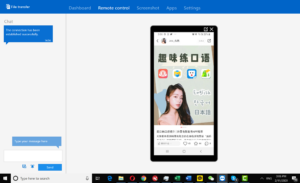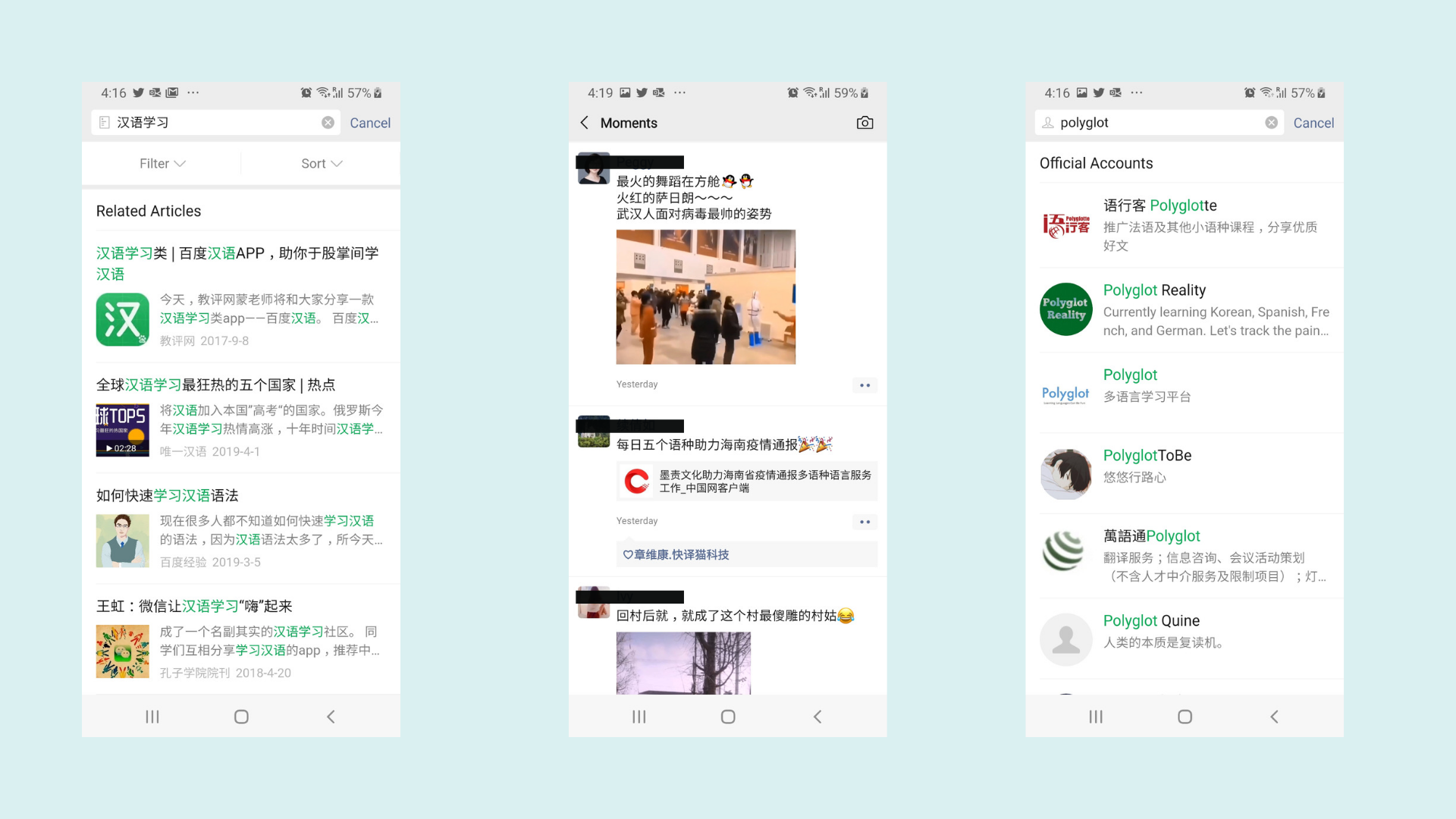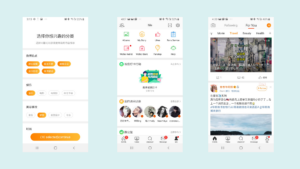When I found out I was going to move back to China, I knew it was finally time to familiarize myself with Chinese social media.
Back in 2008, when I spent my first summer in Beijing, these apps were barely on the horizon. A few short years later, they had taken over.
My Chinese friends were all sending each other multimedia messages with gifs, emojis and voice notes, while my American friends were still sending black and white text messages from their mobile phone native apps.
The only thing stopping me from jumping onboard WeChat and Weibo (besides the fact that I was no longer living in China) was the fact that my Chinese reading ability was still not very high—I still read pretty slowly, and can’t yet “scan” text very quickly for the gist, the way I can scan alphabetic languages like English or Russian.
But, of course, I knew that the very reason I wasn’t using Chinese social media was the very reason I should be using it: to improve both my reading skills and my understanding of modern Chinese culture.
By the way, if you just want a list of helpful social media vocabulary, go ahead and scroll to the bottom!
My Study Strategy
Like most of you, I don’t exactly have endless hours to devote to Chinese study. I need to be really targeted and realistic about my study plans.
So, I decided I would need a social media Sherpa—someone to keep me on track and guide me through the challenging parts of getting online in Chinese.
After all, using ANY new social media involves a learning curve (or is it just me? am I just that old)? I remember grumbling under my breath as I downloaded Instagram at my then-boyfriend’s request. I remember wondering aloud what the point was, when I could already post photos on Facebook. And to figure out how to use stories…should I even be admitting this? I had to Google it.
To get online in Chinese, I found a Chinese tutor on italki to guide me through the process.
To find the right tutor, I sent them a message in advance explaining what I wanted help with: I was looking for a tutor to guide me through the process of setting up these accounts, to show me around the different features, and to help me find interesting accounts to follow.
And that is where I have left it for now…for the past few months I’ve been lurking and learning. I haven’t yet started posting. But soon, I’ll ask my tutor to help me compose natural content to post to my own accounts, so that I can start to engage with the community more.
By the way, if you want more tips on how to use italki to find online language tutors, you can check out my post here.
What You Need to Access Chinese Social Media
A phone, ideally with a Chinese SIM (but that isn’t crucial)
Many of the apps I will talk about below have both browser and mobile versions, but because of the nature of Chinese security, it can be hard to set up a social media account without linking it to a phone number (foreign or Chinese, but Chinese is usually best).
The absolute best way to set up a full-featured social media account is to use a Chinese SIM card (for which you’ll need a Chinese bank account).
The next best is to use a second phone, so that you can set the region of the App Store to Mainland China (note that the Play Store is not available for the Chinese region as Google is blocked there). Just be aware that you’ll need to agree to some Chinese rules and regulations on data privacy…you should do your own research and make sure you are comfortable with that.

If you can’t get your hands on a second phone, you can still set up accounts on your main mobile phone, but some functionalities will be limited.
Personally, I do have a second phone that I have set to Chinese, but right now for simplicity’s sake I’m still just using my main “American” phone to access these apps, because it is a hassle to check two phones all the time. So don’t worry, you can still do a lot with your main phone.
Phone to Desktop Mirroring App
For the purposes of working with my tutor, it was incredibly helpful to mirror my phone display on the screen of my laptop. Then, I would just Share Screen (in Zoom or Skype) and my tutor could see exactly what was happening on my phone without me having to hold it up to my webcam all the time. Team Viewer works great for these purposes.

Why Bother Learning to Use Chinese Social Media?
There Is Just So Much Content In Chinese
After all, social media is China’s lifeblood: with over 1 billion users on Wechat, 500 million users on Weibo, 500 million users on Douyin, 300 million users on Red (Xiao Hong Shu) and 160 million users on Zhihu, modern society revolves around connectivity to these apps.
And keep in mind these platforms are mostly limited to Chinese users (for reasons I’ll explain below). These apps are not yet widely used outside of China. So all of those users—all of those opinions and information-sharers and experts and influencers—are making content in a single language.
No other social media app, English or otherwise, can boast numbers like this – even Facebook, whose main user base is English-speaking, only has 85 million English users.
Of Twitter’s 321 million users, only 14.1 million use the app in English.
So not only does Chinese social media offer a wealth of information, this information is created by content creators who have to make it past A LOT of impatient Chinese eyeballs in order to be seen. This affects the nature and the quality of the content…in some cases for the better (although very possibly, in some cases for the worse).
(And of course the number of eyeballs says nothing about the ACCURACY of the content – China has plenty of fake news, just like the rest of the world does).
What Are Chinese People Thinking and Talking About?
If you want to stay on top of what is happening in China, or what 1.4 billion Chinese think about the latest global events, I can’t recommend social media enough.
After all, if you’re relying too much in textbooks, what are you learning about? Probably Chinese university life, family structures, and some old Chinese mythology, right?
Not that much about current events or ever-shifting societal mores.
If you’re going to spend all that time on social media anyway, you might as well step outside of your bubble and consider the Chinese point of view.
How To Access Chinese Social Media Apps
Chinese Social Media Apps: Why Are There Two Versions?
Like many other Chinese apps (like the Didi ride-hailing app) many social network apps (and browser versions) have separate “Chinese” and “foreigner”-centric versions, which are usually in English and sometimes have a few other languages available as well.
Note, I don’t mean that you just change the language of the app. I mean that it is a completely different app altogether.
Frustratingly, most of the Chinese versions require a Chinese phone number and sometimes further proof of residency.
In some cases there is no English version of the app at all. Because honestly, Chinese businesses no longer HAVE to localize and translate their products for the outside world in order to make enough money to survive. The average Chinese consumer now has money to burn on app stores and emojis and WeChat “red envelopes”, and there are 1.4 billion of those consumers.
When there are two versions of an app, this is often partially due to regulations on data privacy, which vary wildly from country to country. The Chinese government generally has unfettered access to the data stored by any Chinese company.
Europe (and to a lesser extent, the US) have some thoughts on that. Thoughts that have made it difficult for these Chinese apps to bring their apps into territories that don’t share their views on data privacy.
There are probably other technical reasons why they choose to launch two separate apps…if you know more about this than I do, please sound off in the comments!
How to Use the Chinese Version of a Chinese App
The procedures will vary slightly from phone to phone and app to app, so I recommend that you work through this with a Chinese tutor.
However, keep in mind that while they can help you with some of the procedures and the language involved, they will probably be surprised when they see the extra hoops you have to jump through as a foreigner. They probably haven’t even considered what life is like without a Chinese ID card and a WeChat account!
Usually, you will need to find the app in the Chinese version of the App Store. The app might still exist in other stores, but those will usually be versions that are specially localized for foreigners and missing some of the functionalities that the Chinese versions have.
A Note on Changing the Region of Your Apple ID
Changing the region of your Apple ID is a “don’t look back” kind of procedure – it wipes a lot of your location-specific data from your device, and you will need to remove your payment information and enter new payment information linked to a local credit card for the target region.
Instead, I recommend creating a new Apple ID. However, please note that even to download free apps, you need to be linked to a Chinese payment system – and to be linked to a Chinese payment system you will need a Chinese bank account (even for WeChat). And of course for a bank account, you’ll need legal residency in China.
However, good news! At the time that I’m writing this, I’m still getting by on the foreigner versions of these apps, which still have a lot to offer.
I’ve been using apps downloaded from the US app store (since I don’t yet have a Chinese bank account) linked to a Chinese phone number.
The Chinese phone number gave me a few extra functionalities. But before I had my Chinese numbers, I used my US number and still had plenty of access. So don’t give up just because you’re not living in China!
(By the way, if you know of any updates to these challenges, please let me know! Things change quickly in China).
How to Type In Chinese
Before we move on, if you need to know how to type in Chinese, check out my video here.
Top 3 Chinese Social Media Networks You Should Use to Study Chinese
Here are 3 Chinese social media platforms that are definitely worth your time, and can help you to learn Chinese while you procrastinate or read about topics of interest to you!
With over 1 billion users (nearly China’s entire population of 1.4 billion, and really…just give it a couple more years) WeChat (or 微信) is the behemoth of all social media. Nearly every Chinese citizen is on Wechat, and uses it for everything from mobile payments to posting pictures of their breakfast.
Wechat is China’s Google, Facebook, and Whatsapp all rolled into one. In fact, it is actually difficult to live a normal life in China without having a Wechat account, as you use it to pay for food, order food, sometimes even to release toilet paper from a roll.
As a Chinese learner, the most valuable part of this app will be the moments, articles, and groups.
WeChat Moments
“Moments” work sort of like Facebook, with a feed that you can add pictures or text to. As you add friends to Wechat, you’ll be able to see their Moments here.
Articles
Articles are a separate section, and are pretty straightforward: you can search for articles by topic (for example foreign languages, recipes, or Yang Yang). For example, right now everyone is searching for information on the coronavirus. You can use a keyword to do a search relative to articles you are curious about.
WeChat Groups
WeChat groups can be used for study purposes, or you can find groups related to your other hobbies. There are many WeChat groups devoted to teaching Chinese or studying Chinese together.

Want to get really adventurous?
Use the shake function on WeChat to be connected to the last random WeChat user to shake their phone. It basically works like Chat Roulette!
Weibo, or 微博, is the Chinese Twitter. It is used in much the same way, although it has way more features. It is a great way to see what Chinese people are talking about.
This is also a great way to incorporate little bits of reading practice into your day – bookmark Weibo on your browser, and the next time you feel like procrastinating on Twitter – check out Weibo instead!

There is a really comprehensive guide to Weibo here.
If Weibo is overwhelming to you but you still want to know what topics are trending in China, check out Manya Koetse’s What’s On Weibo.
Zhihu
Zhihu is China’s Quora.
And if you haven’t even used Quora yet, you’re in for a treat! This American website lets you ask experts (real and self-proclaimed) about any topic, from “How do you say “잘 부탁드립니다 in Chinese?” to “how familiar are everyday South Koreans with the North Korean accent?” or even “what languages other than Russian don’t distinguish between arm and hand?”
Zhihu is the Chinese version of this. It is a bit more skewed towards personal questions (how can I find a boyfriend”? “what was the hardest lie you ever told”?) but there is also plenty of content related to other topics (for example language learning).
The best way to use Quora or Zhihu is to read answers to questions that are important to you, or better yet, to ask them! You can also follow other users who ask or answer questions that are interesting to you.
If you want to follow me on Quora, I mostly ask and answer questions about Asian languages and culture.
You can also follow me on Zhihu, although I’m still pretty new there. I’ve just started lurking on Quora and haven’t published any questions or answers, but it is my goal for the year to get into the habit!
Xiaohongshu (Red)
Xiaohongshu literally means “Little Red Book” (no, not that little red book).
This is a really interesting platform – think “social e-commerce”. It started as a review app, but now is sort of like Pinterest + Amazon had a really stylish baby.
I can’t give a more comprehensive intro than Dragon Social does here.
I definitely recommend checking out this really unique platform. Just so that you know, it is definitely targeted towards female users (and 88% of its user base is female).

Other Apps
One other app which I’ve yet to try out, but which is on my list and should be on yours:
Douyin (China’s Tiktok): TikTok and Douyin are both owned by China’s ByteDance, and their main difference is really just the language of the interface and therefore, the kinds of users that you can reach. However you do need a Chinese SIM and access to the China appstore in order to access this app.
Other Great Resources for Chinese News and Social Media Roundups
If these apps are too overwhelming to you, you can always subscribe to these two excellent newsletters. These China hands summarize and analyze the latest China news and deliver it to your inbox:
Important Vocabulary for Social Media
| 注册 | zhu4ce4 | to register |
| 登入 | deng1ru4 | to login |
| 取关 | qu3guan1 | to unfollow (on social media) |
| 取消关注 | qu4xiao1guan1zhu4 | to unfollow |
| 追踪 | zhui1zong1 | to follow |
| 油管 | you2guan3 | YouTube |
| 推特 | tui1te4 | |
| 脸书 | lian3shu1 | |
| Ins | Ins | |
| ins风 | ins feng1 | instagram-style |
| 向媒体透露消息 | xiang1 mei3ti3tou4lu4xiao1xi | to put out on social media |
| 上传 | shang4chuan2 | to upload |
| 赞助 | zan4zhu4 | to sponsor |
| 网红产品 | wang2hong2chan2pin2 | influencer products |
| 粉丝 | fen3si1 | fan |
| 美妆博主 | mei3zhuang1bo2zhu3 | beauty blogger |
| 摄像头 | she4xiang4tou2 | webcam |
| 数码产品 | shu4ma3chanpin | digital/tech goods |
| 包裹 | bao1guo3 | to wrap up, package, parcel |
| 亚马逊 | ya4ma3xun4 | Amazon |
| 差评 | cha4ping2 | negative review |
| 好评 | hao3ping2 | positive review |
| 规律 | gui1lv4 | rules |
| 自由职业 | zi4you2zhi2ye4 | self employed |
| 版本 | ban3ben3 | version |
| 抖音 | dou1yin3 | Douyin (Chinese Tiktok) |
| 知乎 | zhi1hu1 | Zhihu (Chinese Quora) |
| 口碑 | kou3bei1 | public praise, public reputation |
| 关键词 | guan1jian4ci2 | keyword |
| 关注 | guan1zhu4 | to pay attention to |
| 公众号 | gong1zhong4hao4 | public |
| 点赞 | dian3zan4 | to like (a post online) |
| 八卦 | ba1gua4 | gossip |
| 朋友圈 | peng2youquan1 | moments (on wechat) |
| 项目 | xiang4mu4 | project |
| 千禧一代 | qian1xi3yi1dai4 | millennials |
| 隐私设置 | yin3si1she4zhi4 | privacy setting |
| 屏蔽设置 | Ping2bi4she4zhi4 | blocking settings |
| 收藏 | shou1cang2 | favorite |
| 订阅 | ding4yue4 | subscription |
| 微信钱包 | wei1xin4qian2bao1 | WeChat Wallet |
| 转发 | zhuan3fa1 | to forward |
| 秒怕 | miao3pai1 | app to record videos |
Have you tried using social media to learn Chinese? Let me know what you think!







